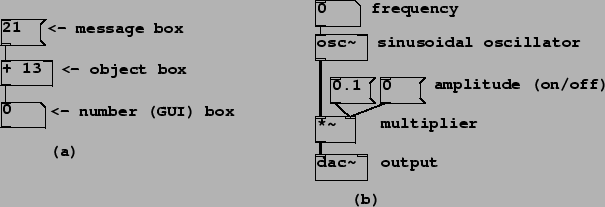




Next: How to find and
Up: About the Software Examples
Previous: About the Software Examples
Contents
Index
Pd documents are called ``patches." They correspond roughly to the
boxes in the abstract block diagrams shown earlier in this chapter, but in
detail they
are quite different, reflecting the fact that Pd is an implementation
environment and not a specification language.
A Pd patch, such as the one shown in
Figure 1.6, consists of a collection of
boxes
connected in a network called a
patch.
The border of a box tells you how its text is interpreted and how the box
functions. In part (a) of the figure we see three types of boxes. From
top to bottom they are:
- a
message box.
Message boxes, with a flag-shaped border, interpret the text as a message to
send whenever the box is
activated (by an incoming message or with the mouse.) The message in this
case consists simply of the number ``34".
- an
object box.
Object boxes have a rectangular border; they use the text to create objects
when you load a patch. Object boxes may represent hundreds of different
classes of objects--including oscillators, envelope generators, and other
signal processing modules to be introduced later--depending on the text
inside. In this example, the box contains an adder. In most Pd patches, the
majority of boxes are of type ``object". The first word typed into an object
box specifies its
class,
which in this case is just ``+". Any additional (blank-space-separated) words
appearing in the box are called
creation arguments,
which specify the initial state of the object when it is created.
- a
number box.
number boxes are a particular case of a
GUI box, which also include push buttons,
toggle switches, sliders, and more; these will come up later in the examples.
The number box
has a punched-card-shaped border, with a nick out of its top right corner.
Whereas the appearance
of an object or message box is static when a patch is running, a number box's
contents (the text) changes to reflect the current value held by the box. You
can also use a number box as a control by clicking and dragging up and down, or
by typing values in it.
In fig.
1.6(a) the message box, when clicked, sends the message ``21" to an
object box which adds 13 to it. The lines connecting the boxes carry data
from one box to the next; outputs of boxes are on the bottom and inputs on top.
Figure 1.6:
(a) three types of boxes in Pd (message, object, and GUI); (b) a simple patch to output a
sinusoid.
 |
Figure 1.6(b) shows a Pd patch which
makes a sinusoid with controllable frequency and amplitude. The connecting
patch lines are of two types here; the thin ones are for carrying sporadic
messages,
and the thicker ones (connecting the oscillator, the multiplier, and the output
``dac ") carry digital audio signals. Since Pd is a real-time program, the
audio signals flow in a continuous stream. On the other hand, the sporadic
messages appear at specific but possibly unpredictable instants in time.
Whether a connection carries messages or signals is a function of the box
the connection comes from; so, for instance, ``+" outputs messages, but
``*~" outputs a signal. The inputs of objects may or may not accept
signals (but they always accept messages, even if only to convert them to
signals). As a naming convention, object boxes which input or output signals
are all named with a trailing tilde (``~") as in ``*~" and ``osc~".





Next: How to find and
Up: About the Software Examples
Previous: About the Software Examples
Contents
Index
Miller Puckette
2005-02-21

